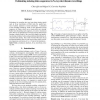Free Online Productivity Tools
i2Speak
i2Symbol
i2OCR
iTex2Img
iWeb2Print
iWeb2Shot
i2Type
iPdf2Split
iPdf2Merge
i2Bopomofo
i2Arabic
i2Style
i2Image
i2PDF
iLatex2Rtf
Sci2ools
INTERSPEECH
2010
2010
Estimating missing data sequences in x-ray microbeam recordings
Techniques for recording the vocal tract shape during speech such as X-ray microbeam or EMA track the spatial location of pellets attached to several articulators. Limitations of the recording technology result in most utterances having sequences of frames where one or more pellets are missing. Rather than discarding such sequences, we seek to reconstruct them. We use an algorithm for recovering missing data based on learning a density model of the vocal tract shapes, and predicting missing articulator values using conditional distributions derived from this density. Our results with the Wisconsin X-ray microbeam database show we can recover long, heavily oscilla
INTERSPEECH 2010 | Signal Processing | Vocal Tract Shapes | Wisconsin X-ray Microbeam | X-ray Microbeam |
| Added | 18 May 2011 |
| Updated | 18 May 2011 |
| Type | Journal |
| Year | 2010 |
| Where | INTERSPEECH |
| Authors | Chao Qin, Miguel Á. Carreira-Perpiñán |
Comments (0)

